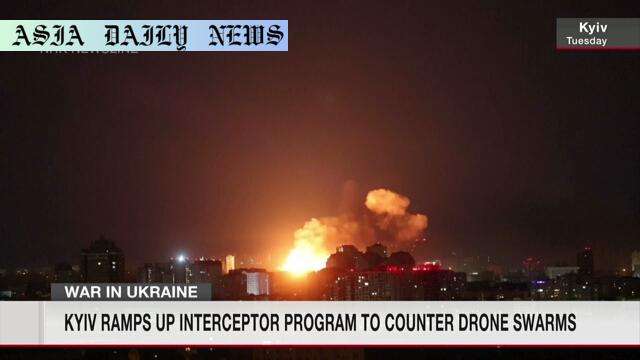Interceptor Drones: Ukraine aims to bolster its air defense by accelerating the development and production of advanced interceptor drones.
Ukraine is enhancing its air defense with advanced interceptor drones.
Russia conducted massive UAV attacks, prompting Ukraine’s response.
Domestic manufacturers are increasing production; Zelenskyy seeks international funding.

Ukraine’s Response to Rising Threats
Amid intensifying aerial threats from Russia, Ukraine is taking decisive steps to revolutionize its air defense with advanced interceptor drones. In recent months, Russia has escalated its attacks, deploying more than 400 unmanned aerial vehicles (UAVs) in a single operation. These figures underscore a pressing need for enhanced security measures to safeguard Ukrainian lives and infrastructure. To counter these aggressive tactics, Ukraine has prioritized the development and production of state-of-the-art interceptor drones, aiming to mitigate the efficacy of Russian UAVs.
For Ukraine, the evolution of interceptor technology is critical to ensuring airspace security. General Oleksandr Syrskyi has acknowledged this shift by emphasizing the strategic value of these drones in combat scenarios. These devices aren’t just tools but strategic assets capable of changing the balance of power in aerial engagements.
Domestic Companies Lead Innovation
President Volodymyr Zelenskyy has shared optimism about the capabilities of domestic companies to lead this transformation. Several Ukrainian firms have made significant strides in interceptor drone technology, and production volumes are steadily increasing. The President’s confidence stems from tangible results delivered by these companies. Beyond national boundaries, Zelenskyy has extended his vision to international forums like the Group of Seven summit. Here, he underlined the importance of global cooperation, urging countries such as Japan and Western allies to contribute their expertise and financial support in drone development.
The decision to focus on domestic production not only boosts Ukraine’s defense system but also strengthens its technological and industrial sectors. These efforts serve as a strong statement of Ukraine’s resilience, even amid adversity.
The Role of International Cooperation
While domestic innovation forms the backbone of this initiative, President Zelenskyy has underscored the necessity for international collaboration. Speaking at the G7 summit, he specifically raised the need for international funding and technical partnerships. Such support could expedite the research and production processes, enabling Ukraine to deploy these interceptor drones more rapidly and at scale.
This global appeal also highlights the broader need to adapt to modern warfare, where drones play a dominant role. Western countries and Japan have both technological expertise and financial resources that could greatly aid this effort, potentially setting a standard for international cooperation in military technology.
The Significance of Interceptor Drones
Interceptor drones represent more than just a tactical response; they symbolize a broader movement toward modernized defense systems. Unlike conventional weaponry, these drones use advanced technologies to either neutralize or incapacitate enemy UAVs. This could range from electronic jamming to physical interception. The versatility of these devices makes them a valuable asset in a theater of war increasingly dominated by unmanned systems.
By focusing on the production of such drones, Ukraine has the potential to not only defend its borders but also gain a technological edge in modern warfare. These developments could position the country as a leader in next-generation defense tech.
Commentary
A Bold Display of Resilience
Ukraine’s decision to ramp up the development and production of interceptor drones is not just a strategic necessity, but also a bold declaration of resilience. The current geopolitical landscape, shaped by rising tensions and persistent threats, has forced the nation to explore innovative paths for its defense strategy. Despite facing challenges, including resource constraints and ongoing aggression from Russia, Ukraine’s focus on interceptor technology demonstrates its unyielding resolve to safeguard its sovereignty.
This move exemplifies a broader trend seen throughout history where adversity prompts innovation. For Ukraine, prioritizing cutting-edge technologies signals both a commitment to defense and a vision for technological advancement. This development not only strengthens the nation’s air defense but could catalyze its progression as a hub for innovation in military technology.
The Importance of Global Collaboration
Ukraine’s appeal for international backing at forums like the Group of Seven summit is a significant step toward globalizing the fight against aerial threats. The increasing role of drones in modern warfare means that nations cannot tackle such challenges in isolation. By encouraging collaboration, Ukraine bridges the gap between national efforts and international support, emphasizing the shared interest in combating emerging technologies used in warfare.
Western countries and Japan have both a moral and strategic interest in supporting Ukraine. Beyond the immediate benefits of defending Ukrainian airspace, this collaboration could foster advancements in interception and defense technologies applicable worldwide. Such international partnerships serve as a reminder of the collective responsibility to uphold peace and security in a rapidly evolving technological age.
Future Prospects and Lessons
What stands out about Ukraine’s approach is its forward-looking perspective. By focusing on an area that has already proven to shape battlefields, it is positioning itself ahead of the curve. Interceptor drones, if effectively developed, could change the dynamics of air warfare, containing UAV threats before they cause significant harm.
As other nations watch Ukraine’s efforts, there are lessons to be learned — primarily the importance of investing in scalable, versatile technologies capable of addressing modern threats. Ukraine’s strategy could potentially serve as a blueprint for countries around the world seeking to bolster their own defenses in an era increasingly defined by unmanned technologies.


